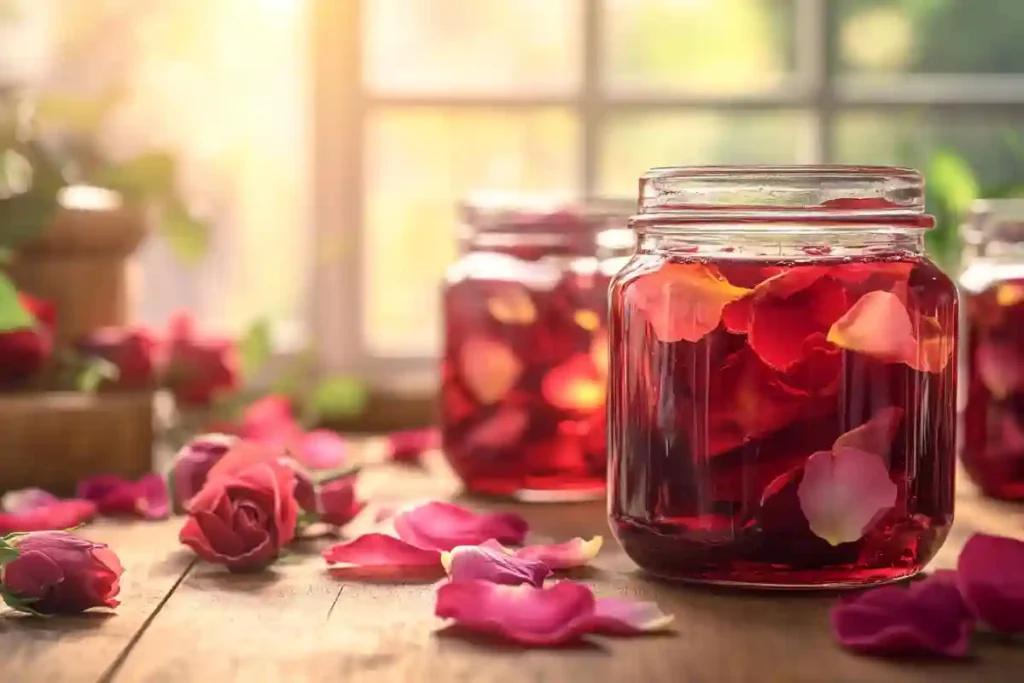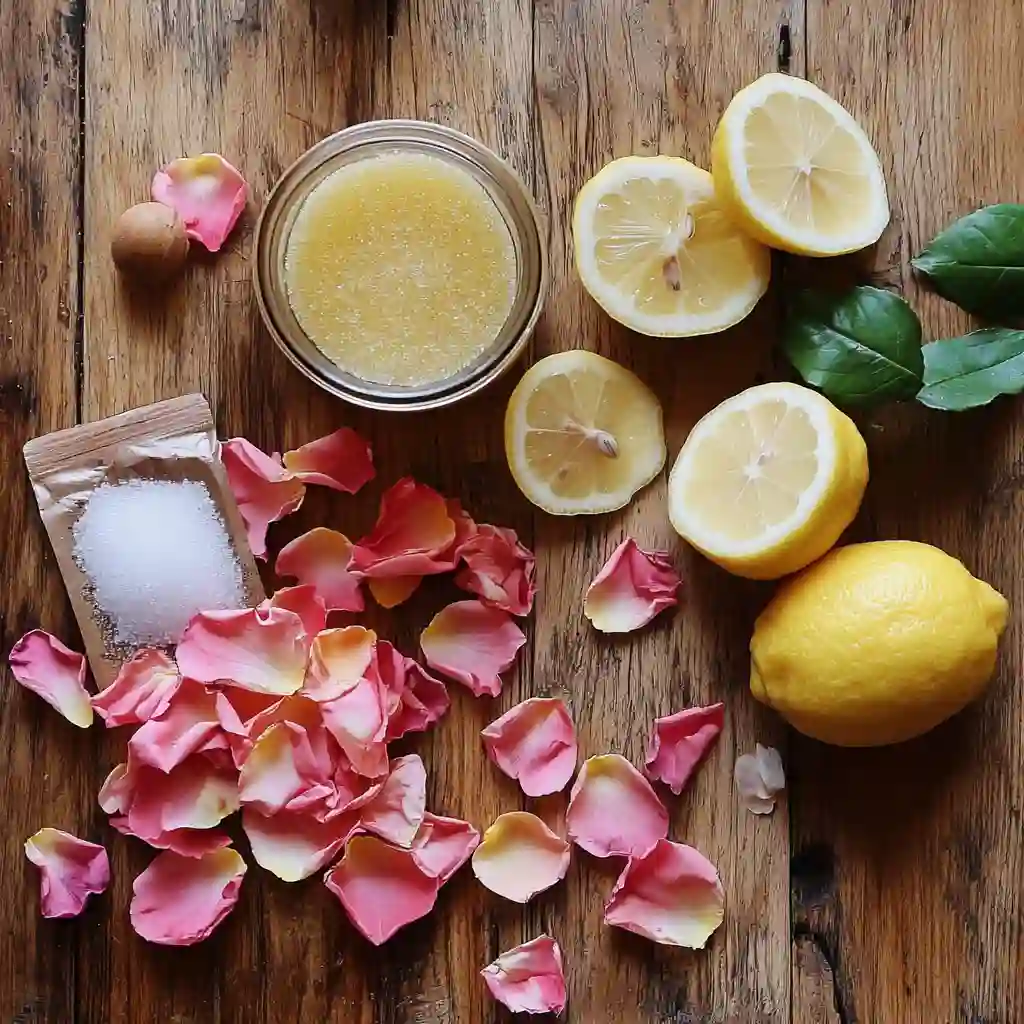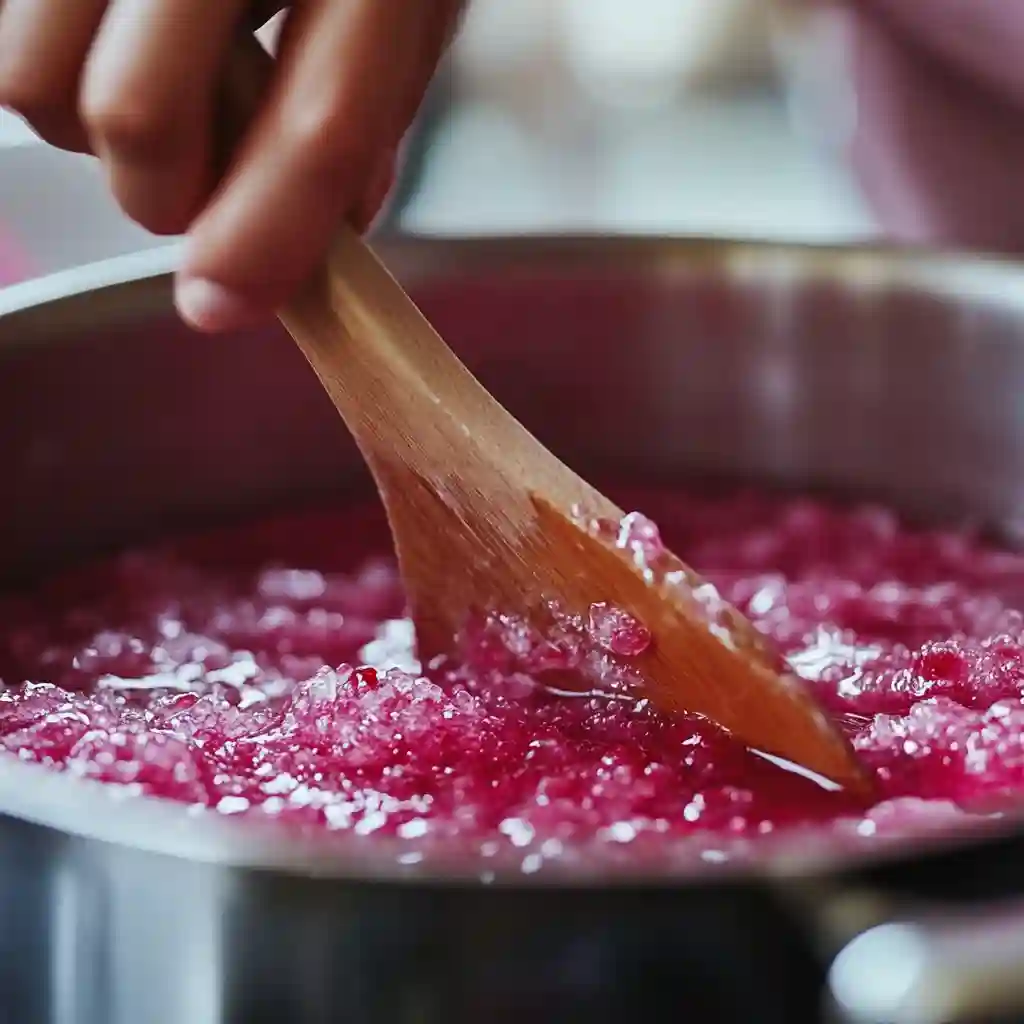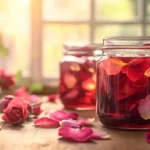
Table of Contents
Ever wandered through a garden and wished you could bottle up its fragrance? That’s exactly how I felt the first time I made a rose petal jelly recipe. It’s floral, lightly sweet, and carries that nostalgic scent of warm June mornings. This article breaks down the beauty of making rose petal jelly at home—from selecting the right petals to the final jar seal. Whether you’re a curious beginner or a plant-based kitchen pro, you’ll learn how to transform simple petals into a pantry treasure. Plus, I’ll answer your top questions about rose petal jelly, jam, and their benefits along the way.
The Story & Intro: Why Rose Petal Jelly is a Garden-to-Table Favorite
From Petals to Preserves: My First Encounter with Rose Jelly
It started with a bowl of freshly foraged rose petals and my mom’s antique jelly jars. I remember standing barefoot in our tiny Portland kitchen, steeping petals in boiling water like they were tea leaves from a sacred ceremony. What came next was pure magic: a jewel-toned jelly with the soft perfume of our backyard blooms. That was the first rose petal jelly recipe I ever made—and it’s stuck with me for over a decade.
What Makes a Great Rose Petal Jelly Recipe?
To get the flavor just right, you need the right roses. Look for organic, fragrant varieties like heirloom or damask roses. Avoid florist roses; they’re often sprayed and lack the delicate flavor you’re after. The jelly gets its taste from steeped petals and its shimmer from pectin and lemon juice, which brings out a subtle tartness and a beautiful blush color.
Many people wonder, what does rose petal jelly taste like? Think floral meets fruity, like a blend of strawberries and tea roses with a whisper of citrus. It’s surprisingly complex, especially when spread on sourdough or dolloped over vegan cheesecake.
One of the best parts? You can also riff on this base recipe to make rose petal jam or even a quick rose petal syrup if you’re short on time—check out how I did that in this rose petal syrup post and my classic rose petal jam version.
And if you love layering botanical flavors, you’ll definitely appreciate candied rose petals as a garnish on top.
Rose Petal Jelly Recipe
Ingredients
- 2 cups fresh, fragrant rose petals (preferably organic, deeply scented varieties like damask or heirloom roses)
- 1 ¾ cups water
- 2 tablespoons lemon juice (freshly squeezed for brightness)
- 1 package (1.75 oz) fruit pectin (like Sure-Jell)
- 3 ½ cups organic cane sugar

Optional:
- 1 teaspoon rose water (for extra floral depth)
- 1–2 drops natural food coloring (if color is too pale for your liking)
Step-by-Step Instructions
Step 1: Prepare the Rose Petals
Gently rinse rose petals to remove dust or bugs. Pat dry with a paper towel. Make sure to remove the white base of each petal—it can taste bitter.
Step 2: Steep the Petals
Bring 1¾ cups water to a boil. Add petals, stir, and simmer for 5–7 minutes until the color fades into the liquid. Remove from heat and steep for an additional 10 minutes.

Step 3: Strain and Measure
Strain the petal infusion through a fine mesh sieve or cheesecloth into a large saucepan. Press gently to extract all liquid. You should end up with about 1½ cups of rose water. If needed, top off with water.
Step 4: Add Lemon Juice and Pectin
Add lemon juice and pectin to the rose water. Stir to combine. Bring to a rolling boil over medium-high heat.
Step 5: Add Sugar and Boil Again
Add all the sugar at once. Stir continuously and bring back to a full rolling boil that can’t be stirred down. Boil for exactly 1 minute, then remove from heat.
Step 6: Skim and Fill Jars
Skim off any foam. Quickly pour hot jelly into sterilized jars, leaving ¼-inch headspace. Wipe the rims clean, place the lids on, and tighten the rings just until they are snug using your fingertips.
Step 7: Process the Jars
Place jars in a hot water bath (boiling) for 5 minutes to seal. Remove and cool on a towel-lined surface. Check seals after 12 hours.

Step 8: Label and Store
Label your jars. Keep the sealed jars in a cool, dark pantry for up to one year. Refrigerate any opened jars and use within 3 weeks.
Rose Petal Jelly Variations You’ll Want to Try
Crafting a Jelly That Reflects Your Garden’s Soul
The beautiful thing about a rose petal jelly recipe is how adaptable it is. Just like a garden changes with the seasons, this jelly can shift with your mood—or your pantry. One of my favorite ways to switch things up is by infusing the steeped rose liquid with a second floral note like hibiscus or lavender. These additions intensify the color and bring subtle, earthy undertones that balance the jelly’s delicate sweetness.
You can also add a hint of spice—think pink peppercorns or a whisper of cardamom. I’ve even made a chai-spiced version using candied rose petals and warm spice blends. If you like your flavors bolder, a splash of pomegranate juice before boiling adds tang and depth.
Want a simpler twist? Stir in rose water or rose petal syrup after removing from heat to enhance the floral aroma without overshadowing the natural flavor.
Tips for Getting the Perfect Texture and Seal Every Time
Texture is key. If your jelly doesn’t set, it usually comes down to pectin or boil time. Use a reliable pectin brand, and make sure you reach a full, rolling boil—this activates the pectin. I recommend using a thermometer (aim for 220°F at sea level) or the frozen spoon test to check for set.
Sterilizing jars and sealing properly is also non-negotiable. I found this helpful breakdown on preserving and canning at The Spruce Eats, especially their section on safe water bath processing. While it focuses on lemon curd, the same methods ensure your rose petal jelly is shelf-stable and gorgeous.
And if you’re going the small-batch route or skipping the water bath, be sure to refrigerate and enjoy your jelly within 3 weeks. For more quick botanical sweets, peek at this chilled rose petal lemonade or even ice cream with rose petals as dreamy pairing ideas.
Why Rose Petal Jelly Is More Than Just Beautiful
The Subtle Health Perks of Rose Petals in Jelly Form
Rose petals aren’t just about fragrance—they’ve been used for centuries in herbal wellness, and jelly captures many of their gentle benefits. When made from organic, edible varieties like those featured in my rose petals guide, the result is not only delicious but potentially soothing too.
So, what is the benefit of rose petals jam or jelly? For starters, rose petals contain antioxidants, particularly polyphenols, which are known to fight inflammation. They’re also traditionally used in herbal medicine for calming digestion, especially when consumed in small daily doses like a spoonful on toast or in tea.
Lemon juice, a common addition in rose petal jelly recipes, enhances vitamin C content and supports natural preservation. Together, these ingredients create a treat that’s as functional as it is flavorful.
Let’s look at how rose petal jelly compares with other botanical preserves:
| Ingredient | Main Benefit | Best Use |
|---|---|---|
| Rose Petals | Antioxidants, digestive calm | Jelly, syrup, herbal tea |
| Hibiscus | Heart health, vitamin C | Tart jelly, iced tea |
| Lavender | Stress relief, sleep support | Infused honey, floral jam |
Creative Ways to Use Rose Petal Jelly Every Day
Now to the fun part: how to actually use your rose petal jelly beyond toast (although, let’s be honest, it’s incredible on sourdough).
Here are smart and unexpected ways to make this jelly part of your regular rotation:
| Use | How To Enjoy It |
|---|---|
| Cocktail Glaze | Melt and swirl into gin spritzers or mocktails |
| Cake Layer Filling | Spread between sponge layers with vegan cream |
| Savory Contrast | Serve with vegan cheeses or roasted nuts |
| Breakfast Brightener | Add a spoon to oatmeal, coconut yogurt, or pancakes |
And for dessert lovers, a drizzle over ice cream with rose petals is the simplest way to impress your guests with very little effort.
FAQs and Final Thoughts on Making Rose Petal Jelly
What does rose petal jelly taste like?
Rose petal jelly has a uniquely delicate flavor. It’s floral, lightly sweet, and sometimes compared to Turkish delight or a faint berry tea. The taste varies by the type of rose used, but heirloom petals give it an almost fruity depth. It’s not overly perfumed—just subtly elegant. If you want a slightly brighter finish, add a dash of lemon zest or rose water at the end.
Can you make rose petal jam?
Absolutely. While jelly uses strained rose water, jam includes the softened petals for texture. My rose petal jam recipe keeps the velvety bite of the petals and pairs beautifully with scones or toast. It’s a great alternative if you don’t want to fuss with pectin or prefer small-batch preserving.
What is the benefit of rose petals jam?
Rose petal jam shares many benefits with jelly. It contains natural antioxidants, may support digestion, and is often used in Ayurvedic and Middle Eastern traditions for its calming properties. Because it includes whole petals, you’ll also retain trace minerals like calcium and magnesium found in organic roses. For more on their wellness uses, explore my deep-dive on rose petals.
How to make rose water jelly?
Rose water jelly is made using distilled rose water rather than steeped rose petals. The steps are nearly identical: combine rose water with lemon juice, pectin, and sugar, bring to a boil, then jar. The result is clear, fragrant, and especially lovely with Middle Eastern desserts or spooned over vegan yogurt. You can even blend steeped rose petal water and commercial rose water for a layered flavor profile.
Conclusion: A Spoonful of Summer in Every Jar
Whether you grow your own blooms or source petals from a trusted garden friend, this rose petal jelly recipe is more than a sweet treat—it’s a connection to nature, a whisper of floral warmth on a gray winter day. With just a few ingredients and a little patience, you can create something lasting, fragrant, and surprisingly versatile.
If this recipe inspired you, don’t stop here. Experiment. Layer. Gift it. Or just savor it slowly, one petal-laced bite at a time.
Print
Rose petal jelly recipe
- Total Time: 20 minutes
- Yield: 4 half-pint jars 1x
Description
A fragrant, elegant rose petal jelly recipe using fresh garden petals and lemon for a bright, naturally floral preserve.
Ingredients
2 cups fresh, organic rose petals (heirloom or damask)
1 ¾ cups water
2 tablespoons lemon juice
1 package fruit pectin (1.75 oz)
3 ½ cups cane sugar
Optional: 1 tsp rose water, 1–2 drops natural food coloring
Instructions
1. Gently rinse and dry rose petals. Remove white bases.
2. Boil 1¾ cups water, add petals, and simmer for 5–7 minutes.
3. Strain rose liquid into a saucepan. Add lemon juice and pectin.
4. Bring to a boil. Add sugar and boil again for 1 minute.
5. Skim foam. Pour hot jelly into sterilized jars.
6. Seal with lids. Process in a boiling water bath for 5 minutes.
7. Cool, check seals, and label jars for storage.
Notes
Use organic petals only. Damask roses give best flavor.
Refrigerate once opened. Lasts up to 3 weeks opened, 1 year sealed.
Great on toast, pastries, or served with vegan cheese.
- Prep Time: 10 minutes
- Cook Time: 10 minutes
- Category: Preserves
- Method: Stovetop + Water Bath Canning
- Cuisine: Botanical
Nutrition
- Serving Size: 1 tablespoon
- Calories: 35
- Sugar: 8g
- Sodium: 0mg
- Fat: 0g
- Saturated Fat: 0g
- Unsaturated Fat: 0g
- Trans Fat: 0g
- Carbohydrates: 9g
- Fiber: 0g
- Protein: 0g
- Cholesterol: 0mg
Keywords: rose petal jelly, floral jelly, vegan jelly
